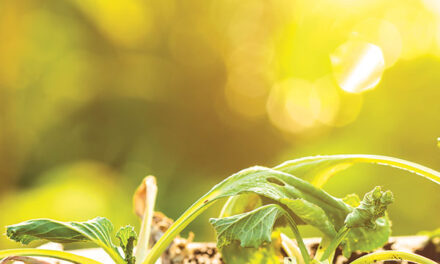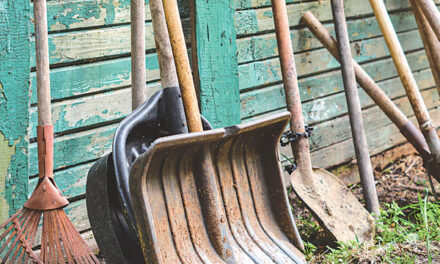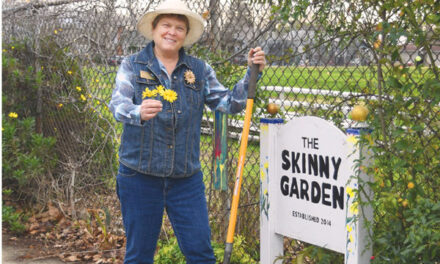Weathered, wrinkled and wrapped in a headscarf, the face was all smiles. Cupped in outstretched hands were three cucumbers. “You?” she asked. How could I refuse?
Thanking her, I felt a twinge of guilt for not being able to match her generosity. A language barrier limited communication, but I knew from past growing seasons that she coveted the cantaloupes growing a few feet away in my community garden plot. None were ripe that day, but there would be cantaloupes to share in days to come.

Sharing and social interaction are among the perks of the community garden experience. Sacramento is blessed with 17 community gardens within city limits. Four more are planned in the next two to four years, says Bill Maynard, Sacramento’s community garden program coordinator. Total community gardens in Sacramento County number around 50.
A community garden is a group of people, organized by cities, counties, park districts, civic-improvement groups, environmental organizations, churches and other groups, who come together to grow fruits, vegetables and flowers on vacant land.
In some cities, they are run as a co-op and governed by the gardeners. The fruit and vegetables grown are the property of the gardeners, although most gardens collect and deliver excess fresh produce to neighborhood food banks.
Maynard has received numerous inquiries about plot availability during the pandemic. Sacramento’s community gardens remain open, but with mask requirements, social distancing, gloves and tool-sanitation practices.
“It’s a great place to get away from everything, to mentally relax during these Covidian times,” says Maynard, a University of California Master Gardener.
Community gardens are divided into individual plots. Gardeners agree to rules and pay an annual fee ($25 to $60, depending on plot size and who sets the price) before planning and planting.
Gardens are large and small and each has its own unique layout and amenities. Fremont Community Garden at 14th and Q streets has 52 plots. Martin Luther King Jr. Community Garden at 3668 Martin Luther King Jr. Blvd. offers 38 plots, three ADA plots, plus a fruit orchard. The Carmichael Community Garden at Sutter-Jensen Community Park has 64 plots. Fair Oaks Park Community Garden boasts 92 plots, but tiny Camellia Park Community Garden at 6650 Cougar Drive has only six. Generally, all the gardens promote organic growing practices.
Neighbors, friends and relatives often share plots and workload, which requires maintaining plots in reasonable fashion. Weeds are discouraged and a plot overgrown with Bermudagrass, field bindweed or yellow nutsedge can result in losing your plot. Workdays are scheduled throughout the growing season when gardeners maintain the common areas.
Ethnic diversity is as high as plot yields. My community garden in Carmichael has had immigrants from Ukraine, Russia, Romania, Belarus, Armenia, Mexico, South Korea and several other countries. While COVID-19 has curtailed the party schedule, normally we gather at least once a year for an in-garden potluck, music and cultural learning. The food is an adventure in ethnic cuisines.
Reasons for joining a community garden vary. Perhaps you live in an apartment or condominium, there is too much shade in your yard, the food budget could use some downsizing or the social interaction with like-minded folks is irresistible. Community gardeners are generous with knowledge.
According to the American Community Gardening Association, a U.S./Canada nonprofit membership organization, community gardens improve quality of life by “providing a catalyst for neighborhood and community development, stimulating social interaction, encouraging self-reliance, beautifying neighborhoods, producing nutritious food and reducing family food budgets.” It also cites opportunities for recreation, exercise, therapy and education.
The pandemic has spurred additional interest in joining community gardens. A few gardens have waiting lists of three to five years, Maynard says.
“Community gardens are a constant go-to in times of stress. They not only nourish the body, but the mind as well,” he says.
For information on Sacramento city community gardens, visit cityofsacramento.org/parksandrec/parks, then “Specialty Parks.” For specific questions, Maynard can be reached at (916) 262-4699 or wmaynard@cityofsacramento.org.
Dan Vierria is a University of California Cooperative Extension Master Gardener for Sacramento County and former Home & Garden writer for The Sacramento Bee. He can be reached at masterg29@gmail.com. For answers to gardening questions, contact the UCCE Master Gardeners at (916) 876-5338, email mgsacramento@ucanr.edu or visit sacmg.ucanr.edu. Follow us on Facebook, Twitter and Instagram: @insidesacramento.















